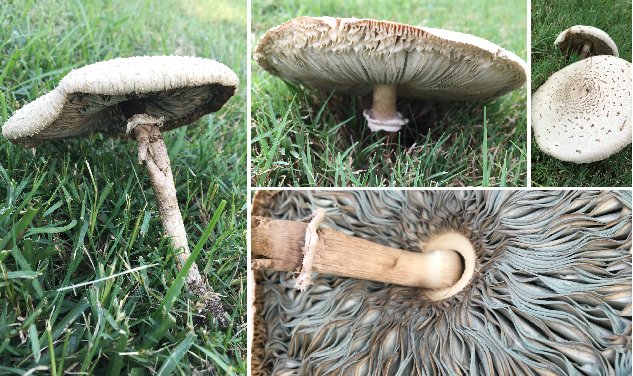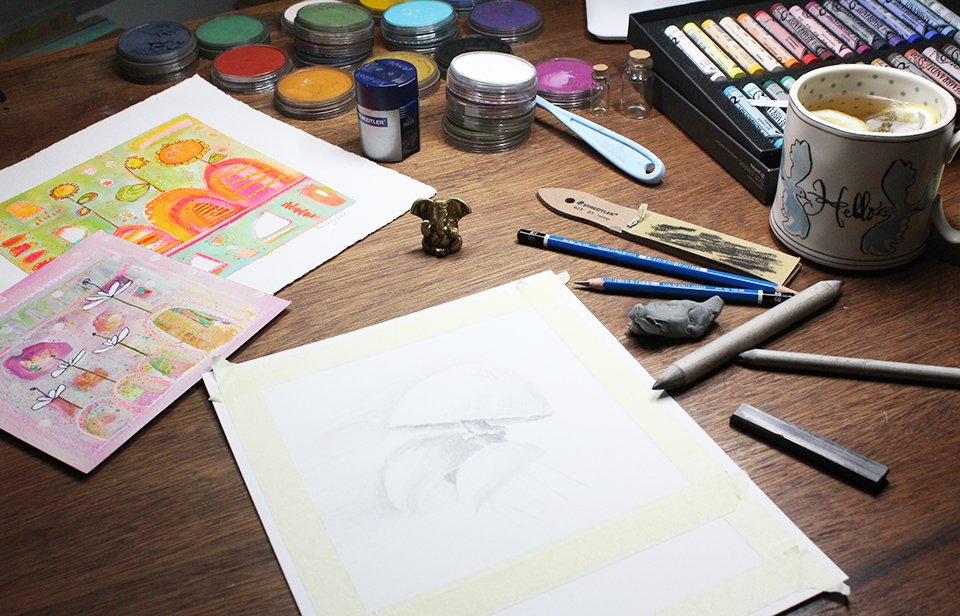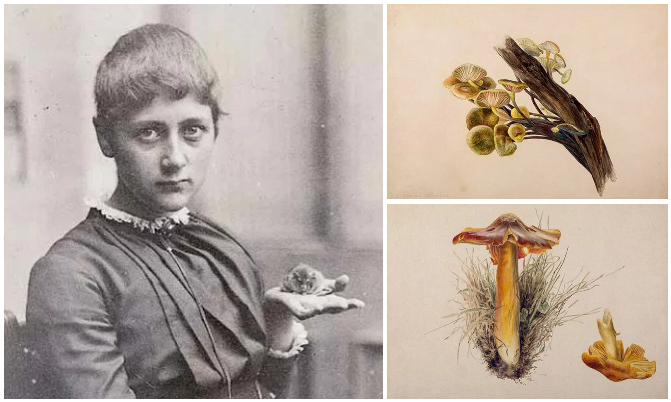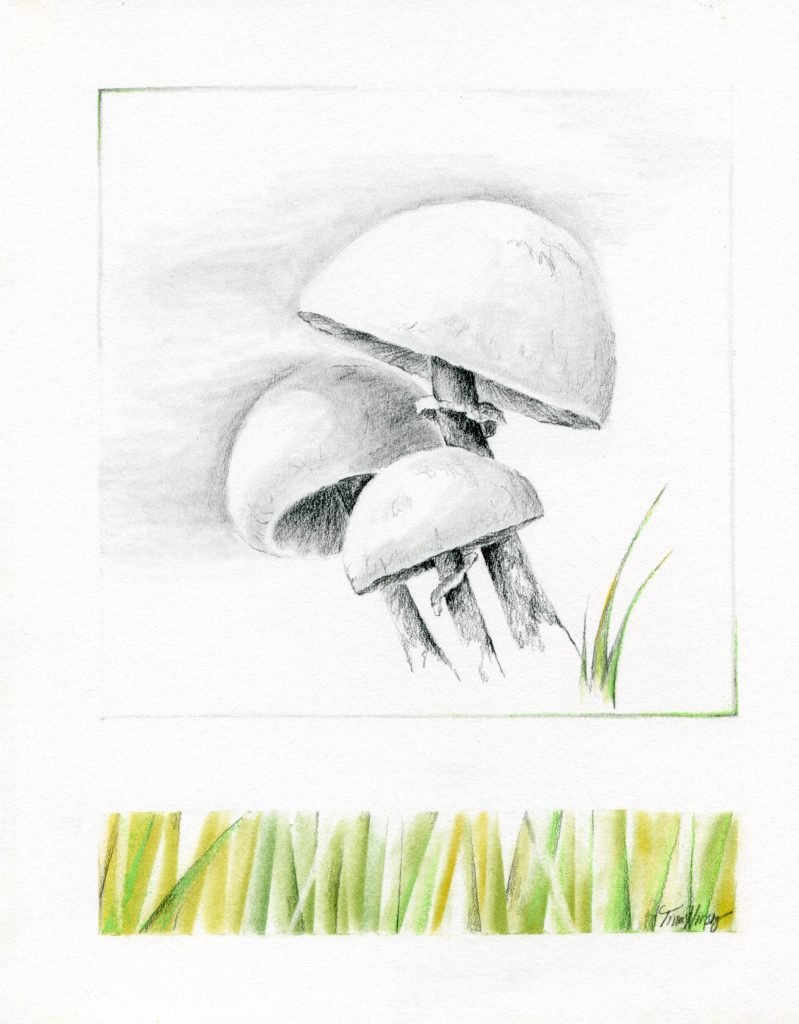The Collective: Mushrooms & Beatrix Potter
 Dear Laura,When I received your new piece of art for The Collective I had to squint:) Those colors are certainly energetic and loud. It's like a party on paper! I know how much the warmth and color of summer inspire you so it's good to see you go all out.Flipping through all the work in The Collective, I noticed a pattern in your work. It looks like hills and sometimes has one single flower growing on top of each. You can see the two pieces I am referring to in the photo below.
Dear Laura,When I received your new piece of art for The Collective I had to squint:) Those colors are certainly energetic and loud. It's like a party on paper! I know how much the warmth and color of summer inspire you so it's good to see you go all out.Flipping through all the work in The Collective, I noticed a pattern in your work. It looks like hills and sometimes has one single flower growing on top of each. You can see the two pieces I am referring to in the photo below. As I was thinking about this while walking my dog in the neighborhood, I noticed mushrooms growing in my neighbor's yards with similar shapes to your "hills". I read that these lawn mushrooms grow on decomposing clumps of soil- most likely piled grass clippings is my guess. I am fascinated by the size of some of these. Look at the color of the gills in one of them- aqua!What do you know about Beatrix Potter? A colleague I teach with was telling me about her work beyond her most famous children's story The Tale of Peter Rabbit. She was a naturalist scientist who studied fungi. The scientist community at the time would not accept her findings because she was a woman, but that did not stop her fascination with the natural world. READ THIS EXCELLENT ARTICLE on Beatrix written by Maria Popova at her website Brain Pickings. The scientific establishment later apologized for this sexism and now mycologists worldwide refer to her work to identify mushroom species.
As I was thinking about this while walking my dog in the neighborhood, I noticed mushrooms growing in my neighbor's yards with similar shapes to your "hills". I read that these lawn mushrooms grow on decomposing clumps of soil- most likely piled grass clippings is my guess. I am fascinated by the size of some of these. Look at the color of the gills in one of them- aqua!What do you know about Beatrix Potter? A colleague I teach with was telling me about her work beyond her most famous children's story The Tale of Peter Rabbit. She was a naturalist scientist who studied fungi. The scientist community at the time would not accept her findings because she was a woman, but that did not stop her fascination with the natural world. READ THIS EXCELLENT ARTICLE on Beatrix written by Maria Popova at her website Brain Pickings. The scientific establishment later apologized for this sexism and now mycologists worldwide refer to her work to identify mushroom species. "Beatrix’s interest in drawing and painting mushrooms, or fungi, began as a passion for painting beautiful specimens wherever she found them. She never saw art and science as mutually exclusive activities but recorded what she saw in nature primarily to evoke an aesthetic response. She was drawn to fungi first by their ephemeral fairy qualities and then by the variety of their shape and colour and the challenge they posed to watercolour techniques."
"Beatrix’s interest in drawing and painting mushrooms, or fungi, began as a passion for painting beautiful specimens wherever she found them. She never saw art and science as mutually exclusive activities but recorded what she saw in nature primarily to evoke an aesthetic response. She was drawn to fungi first by their ephemeral fairy qualities and then by the variety of their shape and colour and the challenge they posed to watercolour techniques."
~Linda Lear (author of Beatrix Potter: A Life in Nature)
While my attempt at drawing the mushrooms in my neighborhood is quite humble compared to Beatrix, it was wonderful to experience bringing together multiple elements of my life into one drawing experience- what I am learning in my teaching about Beatrix, observing our collective work for patterns, and making connections while observing nature on my daily walks. This process of making art always amazes me how it deepens my understanding of the world! I am grateful to be tuned in and have a place to share it in our little corner of the internet.
This process of making art always amazes me how it deepens my understanding of the world! I am grateful to be tuned in and have a place to share it in our little corner of the internet. "Beatrix Potter brought nature back into the English imagination with her books and her illustrations. She wrote most of them at a time when nature was viewed as something of little value when the plunder of nature was more popular than its preservation. After her marriage [to William Heelis] in 1913, the emphasis of her imaginative work shifted more and more away from literature towards the land and the animals it sustained. Beatrix cared about the old ways, and about what was necessary to live simply in nature.Imagination is the precursor to policy, the precondition to action. Imagination, like wonder, allows us to value something. Imagination allowed Beatrix Potter to value the natural world and to share the treasures she found in the Lake District and its culture. As a far-sighted businesswoman, she understood that their preservation was inherently linked to the success of fell farming.Beatrix Heelis’s stewardship created a singular moment in the recovery of nature in the twentieth century; a paradigm of environmental awakening."
"Beatrix Potter brought nature back into the English imagination with her books and her illustrations. She wrote most of them at a time when nature was viewed as something of little value when the plunder of nature was more popular than its preservation. After her marriage [to William Heelis] in 1913, the emphasis of her imaginative work shifted more and more away from literature towards the land and the animals it sustained. Beatrix cared about the old ways, and about what was necessary to live simply in nature.Imagination is the precursor to policy, the precondition to action. Imagination, like wonder, allows us to value something. Imagination allowed Beatrix Potter to value the natural world and to share the treasures she found in the Lake District and its culture. As a far-sighted businesswoman, she understood that their preservation was inherently linked to the success of fell farming.Beatrix Heelis’s stewardship created a singular moment in the recovery of nature in the twentieth century; a paradigm of environmental awakening."
~Linda Lear
